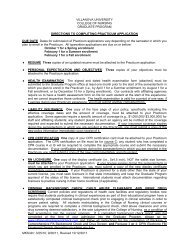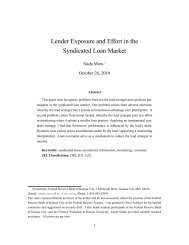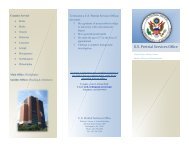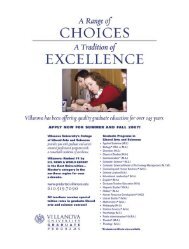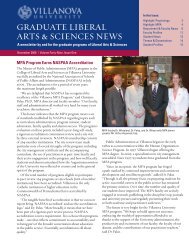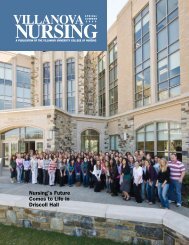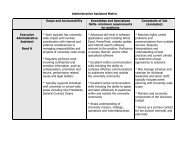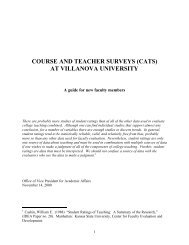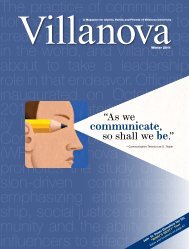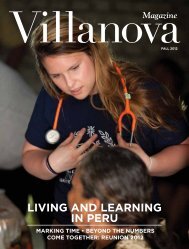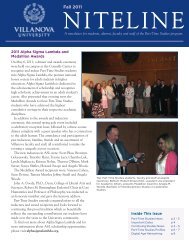ADULT LEARNERS - Villanova University
ADULT LEARNERS - Villanova University
ADULT LEARNERS - Villanova University
Create successful ePaper yourself
Turn your PDF publications into a flip-book with our unique Google optimized e-Paper software.
FACULTY FOCUSStudy Addresses Hypertension among Sugar Cane WorkersIn developing countries, hypertensionis a growing chronic health condition.Its prevalence in the Caribbean is estimatedto be as high as 55 percent in somepopulations—including Haitian migrantcommunities in the Dominican Republic.While there is anecdotal evidence fromhealth-care teams, there is little actual datadue to social class inequities and healthrelateddisparities.Tamara M. Kear ’09 Ph.D., R.N., assistantprofessor in the College of Nursing,has begun a new study to gather such dataamong a neglected group in one of theCaribbean’s poorest areas. Her outreachand research are focusing on the Haitianmigrant workers who live in bateyes, theshanty towns next to the sugar cane fieldsin the Dominican Republic. As an expertin nephrology and dialysis nursing, Dr.Kear sees first-hand how damaging highblood pressure can be to health.In October 2011, eight Nursing juniorsspent Fall Break caring for these Haitianmigrant workers in La Romana, an industrialtown on this developing nation’ssouthern coast. They accompanied Dr. Kearand Kim Connolly, M.P.H., R.N., director of“Neither Haiti nor theDominican Republicrecognizes citizenship ofthese children, who have nocountry to call their home.”—Tamara M. Kear’09 Ph.D., R.N.the College’s Center for Global and PublicHealth, to observe and deliver health care.La Romana is surrounded by mountainsand sugar cane plantations. These workersand their families migrate from Haiti, on theother side of the island of Hispaniola, to harvestthe crop. Despite their quest for a betterway of life and education for their children,they have little or no access to health care.Each day, the Nursing group traveledto a different bateye, providing a mobilehealth-care clinic that assessed and treatednearly 300 people.In conjunction with the students’ healthpromotion work, which was part of theirclinical practicum, Dr. Kear was beginninga new study, “Hypertension in HaitianMigrant Communities in the DominicanRepublic: An Investigation of Three RuralBateye Communities.” Dr. Kear, who hadmade two previous trips, says she chosethis population to study because “They arethe ones who fall through the cracks of thehealth-care system. They are not consideredDominican citizens—even children bornin the Dominican Republic of Haitianparents are not Dominican. Neither Haitinor the Dominican Republic recognizescitizenship of these children, who have nocountry to call their home.” This makes foran increasingly vulnerable population thatmay be left unnoticed and untreated.During the clinics, students checkedblood pressures manually and recordedthem for 285 Haitians 16 years and older.They discussed medication use and accessibilityand gave sessions on hypertensionrisk factors and management. Throughrecorded interviews with health promotersliving in the bateyes, they explored barriersto hypertension management.Dr. Tamara Kear(right) interviewsHaitian migrantworkers in theDominican Republicabout their healthand blood pressurewhile inspiring anew generation ofresearchers. Withher is with AllisonBehette, a Nursingjunior assisting inDr. Kear’s study ofhypertension.Allison Behette, a junior from Brooklyn,N.Y., began working with Dr. Kearduring this health promotion experienceand continues to assist her in data analysis.“Now that I am involved in the hypertensionstudy,” says Behette, “I feel like I amreliving the experience of my time in theDominican Republic and really bringing itto a new level.”Dr. Kear’s study is still in the initialphase, but she is working with GoodSamaritan on a tool the hospital could usein collecting data in her absence. Oncethere is sufficient data, which could takeseveral years, she will seek funding for aninterventional study.Notes Behette, “Going to the DominicanRepublic in October was undoubtedlyone of the greatest experiences ofmy college career. Not only did I gainclinical experience but I had the uniqueopportunity to experience a culture that isvery different from my own. Although itis definitely interesting to see how variousmedical conditions such as hypertensionare affected by demographics, gender,culture and a multitude of other factors,my favorite part of this study is knowingthat whatever we find can make a differencein the lives of a group of people whohave truly touched my heart and changedmy life.” •16 <strong>Villanova</strong> Nursing | Spring 2012



